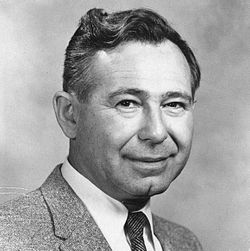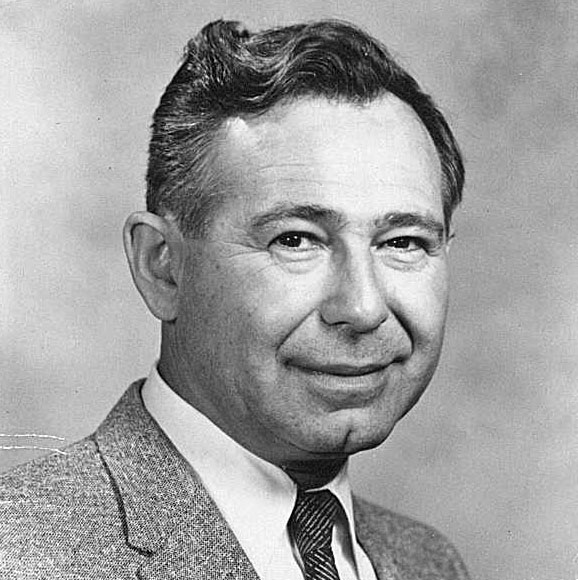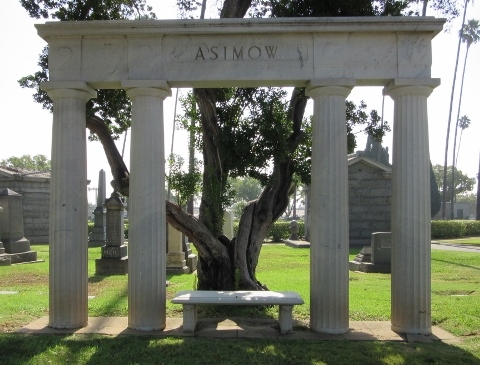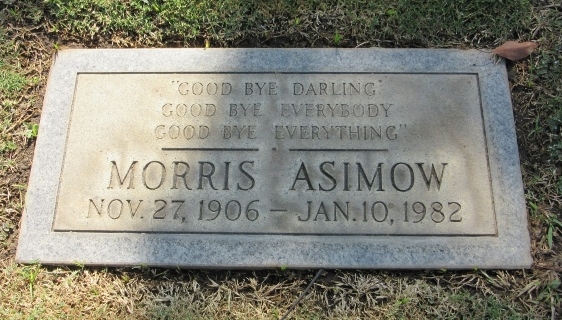Morrie was born in Milwaukee of parents who had immigrated to the United States from Russia. The family moved to Los Angeles during Morrie's childhood and he graduated from the Polytechnic High School. He attended UCLA (still the U.C. Southern Branch at the time), transferring to the Berkeley campus where he earned a teaching credential in addition to the B.S., M.S. and Ph.D.--all in Engineering. The first of many honors he was to receive was that of being named University Medalist.
Professor Asimow's early professional career was in metallurgy--both in teaching at UCB and subsequently in industrial research. His talent for management soon surfaced, and he became general manager of two metals/manufacturing firms. In 1947, after a period of successful, independent professional consulting, he was lured to UCLA Engineering through his high regard for its founding Dean, L.M.K. Boelter. He remained a member of the faculty until his retirement in 1972, and returned from time-to-time thereafter for special assignments. Always an innovator and inventor, he developed and taught the discipline of engineering design and published one of the early texts on the subject per se--in contrast to the traditional design procedure directed to specific areas. In the early fifties, his inventiveness resulted in a medical device that became the standard orthopedic instrument for the determination of hand function. Not only is it still in use today, but it is approved by the California and New York State Accident Commissions as the legal means of evaluating hand-performance.
The underlying idea of what was to become his complementary lifework was born in 1949, when he traveled to New Guinea to recruit native labor and set up a plant to reduce wrecked and surplus war planes to scrap. The success of the enterprise convinced him “that if you could do such a project on an island like this with unskilled natives, you could do it almost anywhere in the world.”
He put his theory to a major test in the early Sixties by launching a series of small-scale factories in the poverty-stricken Ceara region of northeast Brazil. With the help of UCLA and Brazilian students, Dr. Asimow recruited a local board of directors, convinced small landowners to become stockholders in the enterprise, and trained managers and workers.
Within two years, “Project Asimow” had spawned five separate corporations for the manufacture of shoes, radios, ceramics and pressed wood. In an article on the “do it yourself capitalism” project, Time described Asimow as “in a class by himself as a one-man aid program.”
Once well underway, Asimow turned the companies over to complete ownership and management of the Brazilians, asking, as always, no recompense for himself.
The Asimow concept, under his tutelage, spread to developing regions of Mexico and Venezuela, as well as Iran and Greece.
Returning to UCLA, Dr. Asimow turned his vision to his own backyard. Well before the 1965 riots, he began working in the Watts area to try to mesh local capital, professional skill and labor into self-owned and run development projects. One concrete result in the middle and late sixties was the establishment of a plant producing protein-enriched macaroni and spaghetti. He also served as President of the Meals for Millions Foundation, extending its activities to the training of foreign nationals in developing manufacturing techniques for the production of enriched food stuffs in their home countries.
Among other honors, he was awarded the Henry Howe Memorial Medal for metallurgical research, the 1966 Outstanding Engineer Merit Award of the Los Angeles based Institute for the Advancement of Engineering, the 1967 Master Designer Award by Product Engineering magazine, honorary citizenship by the State of Ceara, Brazil, and the Order of the Rio Brancho by the Brazilian government.
Professor Asimow was an engineer who practiced in the field what he taught in the classroom and who believed that the highest purpose of technology was to help people help themselves. Much of this philosophy found its way into his last major achievement, the writing and publishing of a Utopian, science-fiction novel, Tale of Two Planets, which offers a scenario of peace among the superpowers and prosperity in the Third World.
But the recitation of honors and achievements falls far short of adequately reflecting the man. A man of creativity and capacity for continued growth (he began serious study of the Hebrew language after his retirement), and of deep interest in world affairs, he had a global perspective. Particularly devoted to the Middle East, only the spread of his cancer stopped his efforts to develop small industries in the Arab populated areas of Israel. Above all, those who had the good fortune to know, and work with him will remember him as a man of consummate integrity and strong character, tempered always by warmth and human kindness.
Info found here...
Morrie was born in Milwaukee of parents who had immigrated to the United States from Russia. The family moved to Los Angeles during Morrie's childhood and he graduated from the Polytechnic High School. He attended UCLA (still the U.C. Southern Branch at the time), transferring to the Berkeley campus where he earned a teaching credential in addition to the B.S., M.S. and Ph.D.--all in Engineering. The first of many honors he was to receive was that of being named University Medalist.
Professor Asimow's early professional career was in metallurgy--both in teaching at UCB and subsequently in industrial research. His talent for management soon surfaced, and he became general manager of two metals/manufacturing firms. In 1947, after a period of successful, independent professional consulting, he was lured to UCLA Engineering through his high regard for its founding Dean, L.M.K. Boelter. He remained a member of the faculty until his retirement in 1972, and returned from time-to-time thereafter for special assignments. Always an innovator and inventor, he developed and taught the discipline of engineering design and published one of the early texts on the subject per se--in contrast to the traditional design procedure directed to specific areas. In the early fifties, his inventiveness resulted in a medical device that became the standard orthopedic instrument for the determination of hand function. Not only is it still in use today, but it is approved by the California and New York State Accident Commissions as the legal means of evaluating hand-performance.
The underlying idea of what was to become his complementary lifework was born in 1949, when he traveled to New Guinea to recruit native labor and set up a plant to reduce wrecked and surplus war planes to scrap. The success of the enterprise convinced him “that if you could do such a project on an island like this with unskilled natives, you could do it almost anywhere in the world.”
He put his theory to a major test in the early Sixties by launching a series of small-scale factories in the poverty-stricken Ceara region of northeast Brazil. With the help of UCLA and Brazilian students, Dr. Asimow recruited a local board of directors, convinced small landowners to become stockholders in the enterprise, and trained managers and workers.
Within two years, “Project Asimow” had spawned five separate corporations for the manufacture of shoes, radios, ceramics and pressed wood. In an article on the “do it yourself capitalism” project, Time described Asimow as “in a class by himself as a one-man aid program.”
Once well underway, Asimow turned the companies over to complete ownership and management of the Brazilians, asking, as always, no recompense for himself.
The Asimow concept, under his tutelage, spread to developing regions of Mexico and Venezuela, as well as Iran and Greece.
Returning to UCLA, Dr. Asimow turned his vision to his own backyard. Well before the 1965 riots, he began working in the Watts area to try to mesh local capital, professional skill and labor into self-owned and run development projects. One concrete result in the middle and late sixties was the establishment of a plant producing protein-enriched macaroni and spaghetti. He also served as President of the Meals for Millions Foundation, extending its activities to the training of foreign nationals in developing manufacturing techniques for the production of enriched food stuffs in their home countries.
Among other honors, he was awarded the Henry Howe Memorial Medal for metallurgical research, the 1966 Outstanding Engineer Merit Award of the Los Angeles based Institute for the Advancement of Engineering, the 1967 Master Designer Award by Product Engineering magazine, honorary citizenship by the State of Ceara, Brazil, and the Order of the Rio Brancho by the Brazilian government.
Professor Asimow was an engineer who practiced in the field what he taught in the classroom and who believed that the highest purpose of technology was to help people help themselves. Much of this philosophy found its way into his last major achievement, the writing and publishing of a Utopian, science-fiction novel, Tale of Two Planets, which offers a scenario of peace among the superpowers and prosperity in the Third World.
But the recitation of honors and achievements falls far short of adequately reflecting the man. A man of creativity and capacity for continued growth (he began serious study of the Hebrew language after his retirement), and of deep interest in world affairs, he had a global perspective. Particularly devoted to the Middle East, only the spread of his cancer stopped his efforts to develop small industries in the Arab populated areas of Israel. Above all, those who had the good fortune to know, and work with him will remember him as a man of consummate integrity and strong character, tempered always by warmth and human kindness.
Info found here...
Family Members
Sponsored by Ancestry
Advertisement
Advertisement






